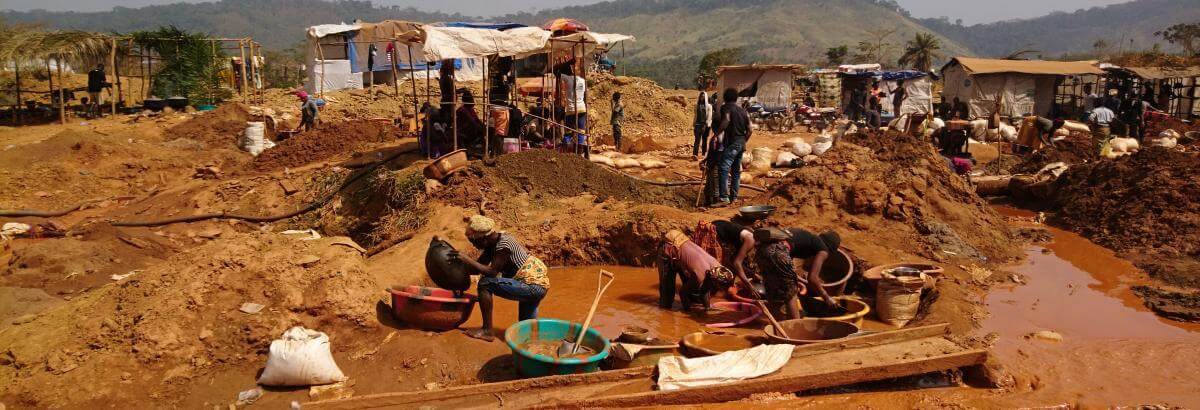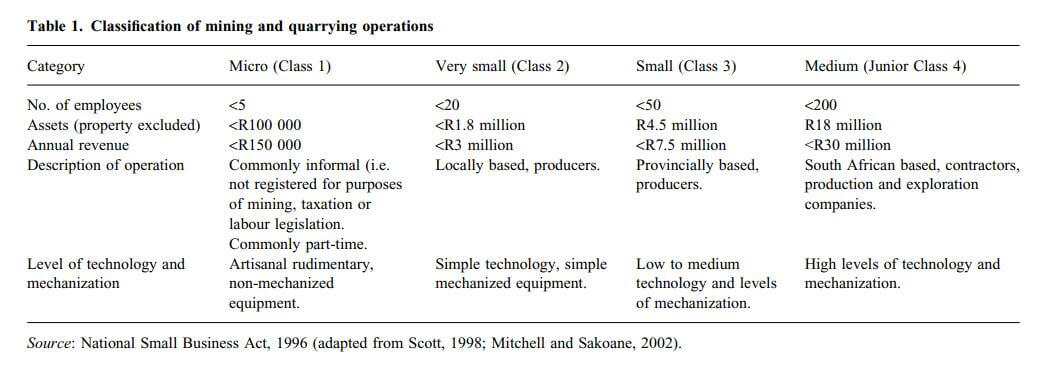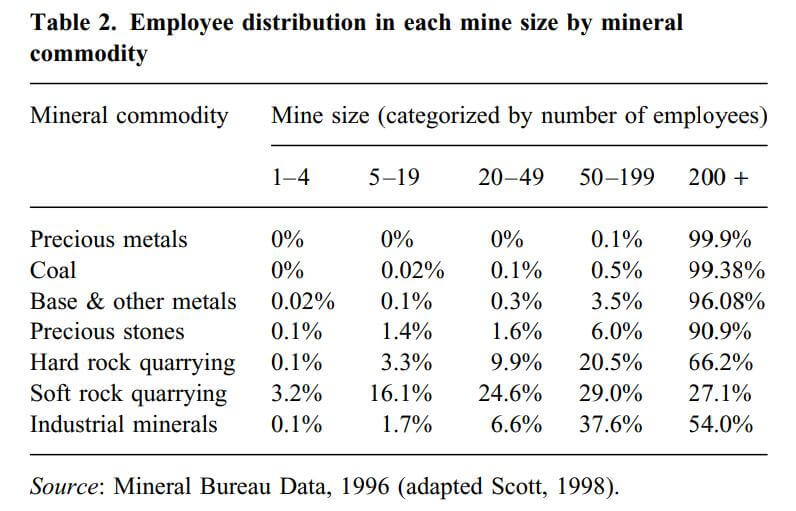1. Introduction
South Africa is endowed with large amounts of mineral wealth and is a global player with regards to the production of minerals and mineral-related products. The country is a major producer of a wide range of minerals, including precious metals, base metals, precious and semi-precious stones, and industrial minerals. Historically, this production can be attributed to large- to medium-scale mines controlled mostly by multi-national companies.
Mining has contributed to the development of an extensive and efficient physical infrastructure and to the establishment of secondary industries. The historical impact of mining on the development of this country is apparent from the correlation of occurrence of high value mineral deposits and levels of development and high population densities. Past policies and discriminatory laws have resulted in lttle development of the small-scale mining subsector and hindered the participation of certain sections of the country’s population.
2. Current status of small-scale mining
2.1. What is small-scale mining?
The definition of small-scale mining (particularly when considering artisanal mining, which is primitive and informal) has been debated at length at different fora. The most commonly used parameters for classification of the scale of a mine are gross annual turnover and number of employees.
The South African Small Business Act of 1996, has classified businesses into micro, very small, small and medium according to criteria such as number of employees, total annual turnover and total assets. However, for mining thisclassification has some shortcomings. For example, on the one hand companies may be employing as few as three highly qualifed professionals as consultants and have a gross annual turnover of over 7.5 million Rand (approximately US$753,770)’, and on the other hand cooperative style mining operations with more than 50 people working a single deposit, using rudimentary methods, could have an annual turnover of less than R150 000 (ca. US$15,075). The majority of the group targeted by the activities of Mintek’ s2 Small-Scale Mining Division and other similar organizations are referred to as artisanal miners who are being supported to become true small-scale miners.
2.2. Areas of activity
Activities are concentrated in the known mineral regions of the country, i.e., gold in the greenstone belts, diamonds where alluvial deposits exist in the Northern Cape and North West provinces. Coal mining at an artisanal level is found in KwaZulu Natal and the Eastern Cape. In the latter, the coal is used mainly for firing clay bricks. Mining methods include open pit to primitive underground excavations.
Some artisanal and small-scale miners informally re-open old mine workings to access whatever ore has been left by the large mining companies. The reworking of dumps left behind by the same large mining companies is also quite common.
The degree of participation of the small-scale mining subsector varies by commodity. This can be seen in the percentage employment of the subsector by commodity (see Table 2). The level of participation is determined by: availability of deposits; ease of mining, processing and extraction of the commodity; and access to markets. Some activities, such as sand and clay mining for brickmaking, are driven by local demand. These deposits fall within the soft-rock quarrying commodity group and are readily available to the small-scale miners. The minimum and uncomplicated processing requirements also make them attractive to this subsector, as reflected by the higher percentage of employees.
2.3. Regulatory environment
There are a number of pieces of legislation that impact on this group of miners and they are the same ones to which the medium and large mining companies are subject. These cover the environment; labour; mineral rights; exploration and mining permitting; and skills development.
The mining policy of most countries, which is enforced by laws and legislative regulations, is usually in a language too complex for the artisanal and small-scale miners to comprehend. Most of these miners are not even aware of the national laws and regulations in force that affect the mining sector and inadvertently violate them. In South Africa the following areas are regulated:
● Mineral rights
The issue of mineral rights in South Africa is under review. Minerals rights are like property rights and are protected by the constitution. Previously, South Africa had a dual system of private and public ownership, but the new Mineral and Petroleum Bill will make the State the sole owner of mineral rights. The issues of royalties, prospecting and mining rights also fall under this bill.
● Health and safety
Health and safety aspects are governed by the Mine Health and Safety Act of 1996. Most of its regulations do not apply to small-scale miners.
● Environment management
In South Africa the environmental legislation is governed by the National Environmental Management Act of 1998, the Mining and Minerals Act of 1991, environmental impact assessment (EIA) guidelines of 1997, the Environmental Conservation Act of 1 986 and the aide-memoire requirements of 1992. With the new legislation, however, all small-scale mining operations applying for prospecting or mining permits are forced to pay a deposit for environmental rehabilitation. Compliance is very low, as non-registration or illegal mining frequently occurs. Similarly, most small-scale miners have neither the resources nor the capacity to carry out an EIA. In response to these problems, the Department of Minerals and Energy (DME) has developed simplified EIA requirements, which are applied to artisanal miners – defined as non-mechanized operations.
● Labour relations
The key pieces of legislation governing labour relations in mining are the Labour Relations Act of 1995, the Basic
Conditions of Employment Act of 1997, the Employment Equity Act of 1998 and the Skills Development Act of 1998. In each case, only small portions of the law are applicable to small- and artisanal mining.
● Skills development
The Skills Development Act of 1998 sets out the frame-work for developing a coordinated approach to skills development in the country. The act was promulgated in order to improve productivity in the workplace, promote self-employment, and encourage employers to use the workplace as an active learning environment and to provide opportunities for new entrants to the labour market to gain work experience. Its regulatory impact on the artisanal and small-scale miners is also limited.
3. Constraints to effective participation of artisanal and small-scale miners in the industry
The efective participation of artisanal and small-scale miners in the sector is hampered by their lack of technical, business and management skills, and by their limited access to mineral deposits, capital and markets. Artisanal/small-scale miners are involved in almost all mineral commodities found in South Africa.
3.1. Limited access to mineral rights and deposits
The availability of deposits and the daunting task of acquiring mineral rights limit the activities of artisanal and small-scale miners. It is often difficult to find out where mineral rights are located. Most artisanal and small-scale mining activities take place around small deposits, unsuitable for exploitation by the large mining companies. This is particularly true of deposits of precious metals and precious stones.
Artisanal and small-scale miners are also often allowed to reprocess tailings dumps left behind by large mining companies. The lack of easy access to mineral deposits could be part of the underlying reasons for the existence of some of the informal artisanal mining activities.
3.2. Lack of access to appropriate technology and skills
Comparisons between different scales of production show that, although the basic industrial processes are the same, the differences in scale often necessitate application of different technologies. With increasing scale, there is a trend towards more sophisticated technologies. For the established small-scale miner, access to technology is not as much of an obstacle as it is for miners lower on the scale (i.e., artisanal). However, common throughout this subsector is the preference for generic technologies that are no longer protected by patents. Patented technologies tend to be too expensive for small-scale operators.
Just as important as access to technology is the ability to use these technologies. Within the upper end of the small-scale mining sector, appropriately qualified skills may be hired. However, at the lower end this is often not feasible.
The negative impacts resulting from lack of skills and limited access to technology are evident in the observed operations that are rudimentary, unsafe, environmentally unfriendly and using inefficient processes. A most horrific example of the negative impacts is misuse of mercury during gold extraction; the mercury is handled unsafely, posing a health hazard and there is no real concern for the environmental impact. Another horrific common occurrence in the small-scale mining subsector is unsafe coal and clay excavations, where the low competence of the rock makes overhangs liable to collapse, resulting in injuries and sometimes fatalities.
In some SADC3 countries, the small-scale miners have been supported by free or subsidized technical and management services training, and by plant and equipment hire administered by governments. Non-governmental organizations have also been known to be instrumental in setting up central processing facilities for use by small-scale miners, e.g., the Shamva Mining Centre in Zimbabwe established by the Intermediary Technology Development Group. This provides an alternative to the somewhat unsatisfactorily custom milling and processing done by the more established small-scale mining companies for the producers at the lower end of the scale (mostly artisanal miners).
3.3. Limited access to capital
Smaller companies have different financing requirements than do larger companies, and they need support from the investment community. I ending to this sector is perceived to be risky; consequently, the domestic banks generally restrict lending to only short-term investments, if they lend at all. This greatly hampers the development of the subsector.
The risk profile of a potential project is at its peak in the early stages and decreases through the development phases. Most companies never find an ore body, but a few are extremely successful. The risks at the early stages, that is, before a pre-feasibility study is completed, are normally beyond what typical commercial banks are willing to expose themselves to.
3.4. Limited access to markets
Low capitalization limits the amount of funds that small-scale miners can allocate to proper market research. At the artisanal level, the process of finding markets is unsystematic and haphazard. In some countries, where small-scale mining activities have been supported through government initiatives, the establishment by government of a central buying facility such as in Zimbabwe一assists the lower end of the scale. However, to more established mining companies, this set-up could一if legislated-become a hindrance to obtaining competitive prices. Some countries, for example Bolivia and Peru, have acted to close their state-controlled mining banks. Others have focused on precious metals and stones, like Vietnam, which has contracted private trading companies to buy rubies from small-scale miners with an agreement to provide training in cutting and polishing to the miners.
No central buying facilities exist in South Africa, but some assistance with accessing foreign markets is available through the Department of Trade and Industry. However, most artisanal and small-scale miners are unaware of the existence of such services, and may also lack the capacity to individually attain the critical mass required by the market.
4. Changing dynamics in small-scale mining
4.1. Opening up of the industry
Policy-makers in South Africa recognize the need to promote the development of an efficient small-scale mining subsector. Legislation in South Africa is being adapted to play an important role in the support of artisanal and small-scale mining and will play a major role in its sustainability. The October 1998 white paper of a new minerals bill, which is currently being debated, stated that“Government will encourage and facilitate the sustainable development of small-scale mining in order to ensure the optimal exploitation of small mineral deposits and to enable this sector to make a positive contribution to the national, provincial and local economy”. The new Minerals and Petroleum Resources Development Bill will open up the mining industry and facilitate new entries. Moreover, the Council for Geosciences is currently developing a central database of all known state owned deposits in South Africa, thus making it easier to find out where mineral rights are located. There is also a need to simplify the process of applying for mineral rights.
The change in atudes has resulted in some encouraging developments, such as joint ventures between small and large mining companies. This allows access for small-scale operations to mineral deposits and sometimes guarantees markets. However, the latter has to be weighed against the same negative impacts experienced with legislated central buying systems. One example of these ventures is in the Northern Cape, where the Small Scale Miners Forum has gone into a joint venture with Samancor,’ which has leased them its mineral rights to some manganese deposits. Some large mining companies have allowed small-scale miners to rework their tailings or marginal areas with the understanding that all the production would be sold through the large companies. At the O’Kiep Mine, a group of small-scale miners have been allowed to upgrade oxide copper dumps by handpicking and selling the concentrate to the mine.
4.2. Support and promotion of the small-scale mining sector
Small portable gold washing plant for sale
The project on Mining, Minerals and Sustainable Development (MMSD)” in Southern Africa made recommendations for the support of the small-scale mining subsector by providing appropriate training and capacity-building programmes through partnerships among government, educational institutions, companies and donors.
It also recommended the creation of a regional forum to promote the development of a harmonized regional legal framework. In many countries where small-scale mining activities are present, the necessary services are made more accessible through government programmes; these may sometimes include subsidized rates.
In South Africa there is a host of companies and individuals that offer services to the small-scale mining sector at normal market rates. Some of these service providers are government science councils such as Mintek, the Council for Geosciences and CSIR ‘s° Miningtek. Low capitalization of small-scale mining projects makes accessibility to overseas service providers extremely dificult.
For the lower end of the small-scale miners, the National Steering Committee of Service Providers to Small- Scale Miners (NSC) was formed by the Department of Minerals and Energy to offer a more accessible service in a one-stop-shop configuration. The main motivation behind the establishment of the NSC was to correct the practices of
artisanal mining especially unacceptable safety standards and environmentally unfriendly methods一by assisting this type of operation to advance to the higher level of small-scale mining and ensure sustainability. The services of the NSC are also extended to:
● First-time entrepreneurs with limited experience and expertise and who are trying to enter the mining sector by starting green-field operations;
● Formal small- or medium-sized operations that are operating below the potential of the deposit being exploited, due to lack of expertise and expansion capital. The NSC includes specialists in geological prospecting, mining, minerals processing, diamond recovery, capacity building and manufacturing. The Committee represents the following organizations: Mintek, Miningtek, the Council for Geosciences, Ntsika, the Industrial Development Council (IDC) and Khula. The NSC also gives financial support through IDC and Khula.
Other finance institutions involved or having an interest in the small-scale end of the mining sector include the New Africa Mining Fund7 and the International Finance Corporation (IFC). These institutions are involved, or wish to be more involved, in the sector as they believe that the small-scale mining sector is a potential growth area, particularly in light of the new minerals bill. The investors in the New Africa Mining Fund (NAMF) will include South African financial institutions, mining houses and development finance institutions. It is expected that NAMF will invest in smaller mining ventures and promote junior mining activities. The Fund is supposed to invest at the pre- feasibility, feasibility and early production stages of smaller mining projects. Funding will be approved according to criteria that include:
● The viability of the project;
● The composition of the promoting agent;
● Black economic empowerment criteria.
4. 3 Skills development
The Skills Development Act of 1998 is being enforced through the setting up of a National Skills Authority, imposing a skills- development levy on employers, setting up a National Skills Fund, developing labour centres and setting up a skills development planning unit.
In the mining sector, the Skills Development Act is implemented through the Mining Qualifications Authority. This body is responsible for the development of unit standards, national and accrediting qualifications, and of training providers in the sector. Several groups have been formed to generate standards and qualifications to cover the different areas of the mining sector, one of which specializes in the small-scale mining subsector. The skills requirements for artisanal and small-scale miners are covered by the following broad areas:
● Geology;
● Mining;
● Mineral processing;
● Environment;
● Health and safety;
● Operational management;
● Marketing;
● Financial management;
● Human resources management;
● Business planning.
5. Growth of the small-scale mining sector
The small-scale mining subsector has great potential for growth. This potential can be realized through coordinated activities, such as those of the NSC, and as part of the integrated rural development plans for local government.
The underlying ethos in all the initiatives is the drive towards sustainable development through beneficiation, downstream processing and adding value. Mintek’s intervention strategies to support artisanal and small-scale miners include:
●Beneficiation and value-addition development programmes for poverty alleviation focused on the rural development nodes of South Africa;
●Development/application of appropriate and safer technologies;
●Facilitation of technology transfer through training;
●Provision of entrepreneurial skills and access to technology, mineral deposits and financial resources.
LATEST PRODUCTS
Tubular Screw Conveyor
【Capacity】6-50 m3/h【Procesible Material】 …
Heavy Plate Feeder
Capacity: 100-240 m3/h Power: 15-45 kW Speed: 0…
Plate Magnetic Separator
【Capacity】8-35 t/h 【Power】1.5-3 kW 【Applic…












